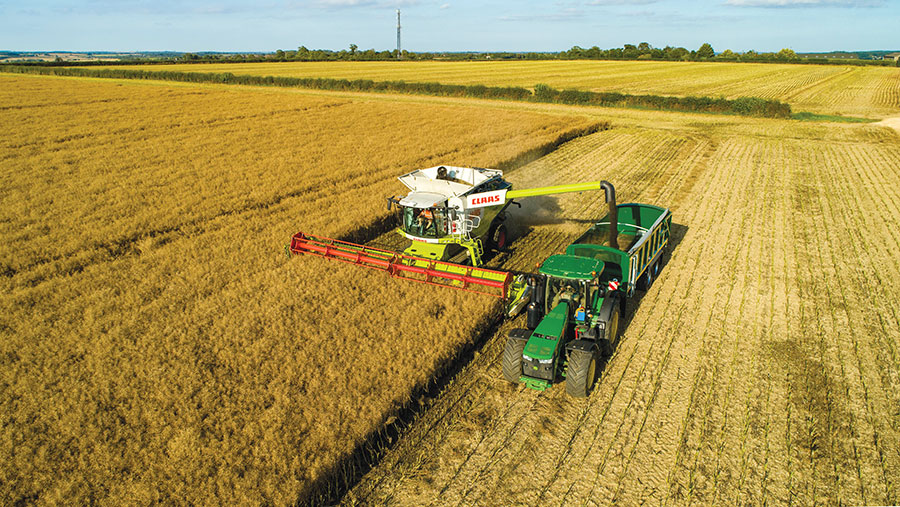Demand for healthy fish and chip oil sees premium for OSR growers
 © Tim Scrivener
© Tim Scrivener Oilseed rape growers are set to get a boost from the humble fish and chip shop, as high street fryers turn to healthy rapeseed oil that will earn farmers a price premium.
Rapeseed crushing giant ADM is launching a new 100% rapeseed product for the UK’s 10,500 chippies, and is hoping more growers may look to grow healthier oilseed rape varieties.
The product uses high-oleic, low-linolenic (Holl) oilseed rape varieties, with growers currently contracted to produce this rapeseed for 2020 and 2021 harvests, and the crusher may need more for 2022 harvest. These Holl varieties make up about 5% of the UK oilseed rape area.
Andrew Marriott, UK brand and marketing manager for ADM’s Frymax brand of cooking oils, is looking for the new oil to take 35% of the fish and chip shop demand, as it gives a long-lasting and healthier product for the daily fry.
“We firmly believe the brand will grow and hope we will be looking for more tonnage and more growers,” he says.
See also: How OSR establishment risk-share schemes compare
Fish and chips
The £1bn fish and chips industry uses about 100,000t of oil a year, and Mr Marriott hopes the new product will make big inroads into this market and also the wider food service area.
The group’s 100% high-oleic rapeseed oil (Horo) product has shown a 300% longer frying life than standard rapeseed oil, and is claimed to be one of the healthiest oils on the market.
The launch of Horo comes just as fish and chip shops start opening up as the coronavirus lockdown is eased, and the frying industry’s reaction has been enthusiastic.
Fish and chip shops in southern and eastern England largely use rapeseed oil, while further north more palm oil is used, and into Scotland animal fats are also used.
Mr Marriott hopes to capture the 35% of the national market using rapeseed in the South and make inroads further north. The company already produces a conventional rapeseed oil, a rapeseed and palm oil blend and a solid palm oil product.
The Holl rapeseed varieties are crushed at ADM’s giant Erith plant in northern Kent and bottled at its plant at Purfleet, across the River Thames in Essex.
Holl varieties
Currently, the only Holl variety on the AHDB Recommended List is V316OL from Bayer’s Dekalb, but the group is offering a new, improved variety for the 2021 harvest crop.
The existing V316OL has a gross output 11% below the top-yielding variety on the list, but the breeder’s next variety, V367OL, available to drill for the first time this autumn, has a higher yield and better agronomic features.
The variety has rapid autumn leaf development to grow away from early pest attack and establishment problems, and company trials show it giving a gross output 4% higher than V316OL.
Edward Hagues, Bayer’s oilseed rape campaign manager, says the new variety will help offer growers a Holl price premium for an increasingly stable and growing UK market.
“Contracts offering attractive premiums on top of oil bonuses are available for harvest 2021 from seed suppliers across the country,” he says.
Price premiums
Premiums for Holl oilseed rape are about £25/t for 2020 harvest, but a key question is how much rapeseed there will be in the future and at what price.
The area for this summer’s drilling could drop below 300,000ha, compared with an estimated 361,000ha in the ground and a 2012 harvested crop of 756,000ha, with this fall due to establishment problems and cabbage stem flea beetle damage.
Owen Cligg, trading manager at co-operative United Oilseeds, says there is a need to find new markets for rapeseed oil as demand for biodiesel wanes.
“We want to see high-oleic oil make bigger inroads into the market, but we don’t want to see it priced out of the market,” he says.
An expected small rapeseed harvest this summer is supporting mainstream rapeseed prices at about £315/t ex-farm for July and August, but in the wider food industry, high-oleic sunflower oil, used by some crisp makers, is become more attractive.

